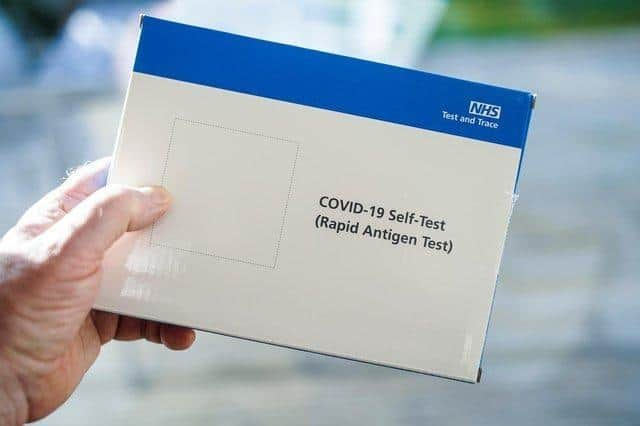List of Covid symptoms expanded: here are the nine new signs of coronavirus
and live on Freeview channel 276
The extension of the symptoms list to include ailments such as sore throat, fatigue and headache could help to reduce infections, one expert said.
News that the symptoms list has been updated emerged just days after the Government ended the offer of free universal Covid-19 tests.
Advertisement
Hide AdAdvertisement
Hide AdIt comes as Covid infection levels have hit a record high in the UK, with almost five million people estimated to be currently infected.


Downing Street defended axing free tests on Monday, saying lateral flow spending was “simply unsustainable”.
Prime Minister Boris Johnson’s official spokesman said: “I think we need to look at where we are in the course of this pandemic.
“We know there is relatively high prevalence of Covid at the moment but, because of vaccines, because of therapeutics and other approaches, we are not seeing it have the knock-on impact when it comes to requiring the most intensive hospital treatment.
Advertisement
Hide AdAdvertisement
Hide Ad“At the same time the provision of free tests was costing taxpayers £2 billion a month and that is simply unsustainable.”
“The spokesman said ministers expect the public to use their ‘good judgment’ now on whether to go out if they have coronavirus-like symptoms.
“I think anyone, even pre-Covid, would recognise if they have symptoms of an infectious disease something like flu they should stay home and not infect their loved ones or colleagues and it is that sort of good judgment that we expect to see going forward,” he said.
The new symptoms have been added to the NHS website, along with the three traditional symptoms of a fever, a new and persistent cough, and a loss or change in taste or smell.
Advertisement
Hide AdAdvertisement
Hide AdAccording to nhs.uk the signs of Covid-19 that people should look out for also include:
* shortness of breath;
* feeling tired or exhausted;
* an aching body;
* a headache;
* a sore throat;
* a blocked or runny nose;
* loss of appetite;
* diarrhoea;
* feeling sick or being sick.
A note on website adds: “The symptoms are very similar to symptoms of other illnesses, such as colds and flu.”
Both the World Health Organisation and the Centres for Disease Control and Prevention in the US have had longer symptom lists for some time.
But in the UK the list had just three symptoms on the list for almost two years.
Advertisement
Hide AdAdvertisement
Hide AdIt is understood that the Government’s chief medical officer would have needed to sign off on the expanded list of symptoms.
The news of the change to the NHS list emerged just days after free universal testing for Covid-19 ended in England.
While some people still qualify for free tests in certain circumstances, the majority of people are now expected to go without or pay.
Under the previous testing regime people would only qualify for PCR tests – those performed in a lab – if they had one of the three main traditional symptoms or if they had been invited to take a test.
Advertisement
Hide AdAdvertisement
Hide AdProfessor Tim Spector, lead scientist of the Zoe Covid-19 symptom tracker app, wrote on Twitter: “NHS official Main symptoms of coronavirus (COVID-19) have finally changed after 2 years of lobbying and Zoe app user input – hurrah! Pity they have the order wrong – but it’s a start and could help reduce infections. thanks ZOE loggers!”
In March Prof Spector was highly critical of the Government’s “refusal” to recognise a “wider array of symptoms”.
He suggested that not acknowledging the wider list of ailments afflicting people with the virus, along with the decision to drop isolation advice and withdraw free testing, could have driven up transmission rates.
Prof Spector said in March: “The Government’s refusal to recognise the wide array of symptoms and to drop isolation advice and testing is likely driving the incredible number of cases we see today.
Advertisement
Hide AdAdvertisement
Hide Ad“Many people are no longer isolating when they have symptoms, either because they feel they don’t have to anymore or because they or their employers still don’t recognise symptoms like runny nose or sore throat as Covid.”
Commenting on the updated symptom list, Prof Spector said: “The addition of more symptoms is definitely a step in the right direction and it could help reduce infections as we go forward.
“However, whilst this is good news, I’d like to see the order of the symptoms changed, as the NHS list puts far too much emphasis on symptoms like fever, and anosmia, which we know are much less common since the Omicron variant emerged.
“According to the Zoe Covid Study, the top five symptoms being reported by contributors with a positive Covid test are runny nose, fatigue, sore throat, headache and sneezing.”
Advertisement
Hide AdAdvertisement
Hide AdOn Friday the Office for National Statistics (ONS) said that some 4.9 million people in the UK are estimated to have had Covid-19 in the week ending March 26, up from 4.3 million in the previous week.
The ONS said an estimated one in every 13 people in England had the virus during that week.